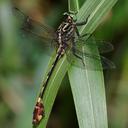United States and Canada
This eastern species is widespread throughout the Austroriparian biotic province, except in Louisiana. The pale green face is broadly striped with black and the humeral and middorsal thoracic stripes are generally confluent at their upper ends, leaving the antehumeral stripe free at its upper end. The thorax is yellowish-green with the thin midlateral stripe often interrupted above the spiracle. The third lateral stripe may be present, but is usually lacking. The abdomen is black except for a thin interrupted pale yellow middorsal stripe and pale areas laterally on the basal segments. Segments 7-9 are broadly expanded with only a small basal yellow spot laterally on 8 and broad irregular lateral stripe on 9.
Size: Total length: 46-57 mm; abdomen: 33-42 mm; hindwing: 27-35 mm.
Similar Species (south-central US): This species is closest to Gulf Coast Clubtail (G. modestus), but that species is generally paler and has a narrow dark stripe on the face and distinct yellow spots laterally on segments 8 and 9.
Habitat: Medium-sized rivers or lakes with areas of alternating sand and gravel.
Natural History: Cobra Clubtails in Texas are larger and more brown in color than typical northeastern individuals. Cobra Clubtails are unusual among most clubtails, in that they are commonly found in both lakes and streams. They will perch on rocks along the margin of the rivers or lakes they inhabit. This species has been recorded in Louisiana based on sight records, but further investigation suggests these records are most likely attributed to Cocoa Clubtail. This species should, however, occur in Louisiana.
Distribution: Eastern U.S. westward to Texas.
Source: Abbott, J.C. 2006-2010. OdonataCentral: An online resource for the distribution and identification of Odonata. Available at OdonataCentral.
Edited by Drew Weber (9/24/2015).

